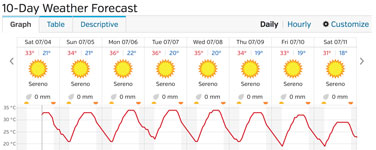CdP
5 July 2015
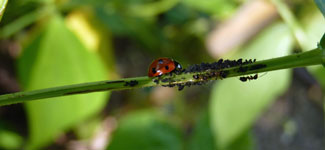 |
 |
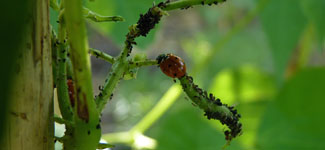 |
||||
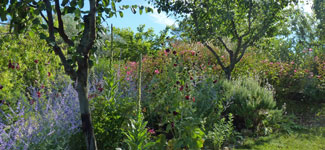 |
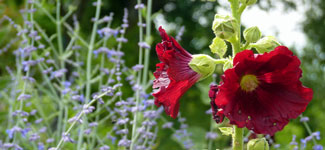 |
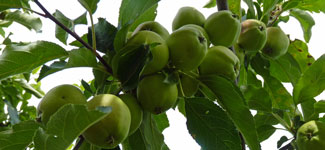 |
||||
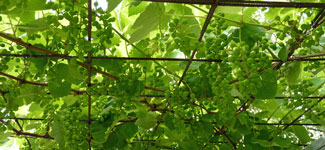 |
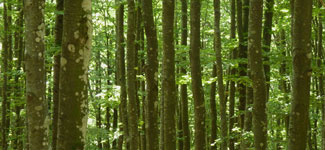 |
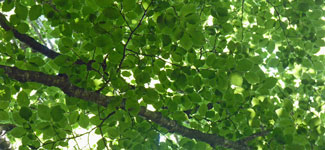 |
||||
I’m in love with my ladybirds: helpful, valiant creatures. My French (green) beans were black with aphids, and alive with their evil minders – ants. I went up to the orto one evening and sprayed the plants with pyrethrum; the infestation was so atrocious that I knew I’d have to repeat the treatment. But I didn’t, because the next time I thought of getting my sprayer out, there were a few ladybirds ambling up the beanstalks: not wanting to hurt non-harmful visitors seemed a fine excuse to go off and do something more enjoyable.
The next evening there were more ladybirds, then more and more until the whole bean patch was a picture of red, spotty, waddling contentment. It was probably my over-excited imagination but I was sure I could see the ladybirds getting rounder and plumper before my very eyes.
And then the aphids were gone. There were some hollow black shells, and some very confused ants. The heroic ladybirds had guzzled the lot.
I like to think of myself as virtuous in my garden. I use organic seeds; I don’t use synthetic chemicals; I’m sparing with acceptable treatments, resorting to them only in cases of dire necessity (though I have to concede that my failure to use these is as much due to abject laziness and disorganization as it is to forebearance). And I’m always keen to follow well meaning tree-hugger advice and let natural garden synergies do the work of keeping things working smoothly for me. But it can be hard. However much you will all these virtuous circles to be unleashed in your wildly paradisiacal garden, more often than not they aren’t. It can be very difficult to fight back the waves of frustration.
And so I am doubly in love with my ladybirds – for cleaning out my beans and for rewarding my patience (such as it is) and showing me that natural methods (occasionally) do work. My only worry now is whether these wonderful insects will feel my love sufficiently to be drawn back. Because the evil ant minders have taken note of the ladybirds’ departure to buggier parts and are herding some aphid-replacements on to my plants. Shall I make with the pyrethrum, or cross my fingers and hope?
About a week ago temps shot up to well over 30° – over 35° most days – and they have stuck. Today, sick of being unable to breath, we took the car and drove up Monte Amiata. Watching the temperature decline as we climbed was pure joy. From 36° (97°F) at Chiusi, we reached 24° (75°F) just beneath the peak at about 1700m. It was bliss.
We padded over a thick carpet of bronze beach leaves and clambered over mossy stones until we found a place to perch with our picnic. Beech trees make a magical scene: little ground-level vegetation, no understory to mention, the long straight verticals of well coppiced wood and that dense, zingy green canopy of perfectly arranged foliage.
Beech forests do that odd silencing thing. L was arguing that you don’t even get birdsong in beech forests but there were plenty of winged creatures proving him wrong there. What you do get, though, is a strange deadening effect on footsteps and voices. We parked the car just below the summit, and strode past the many people sitting prudently on deckchairs where they could keep an eye on their vehicles and not have to deal with too much nature in its wilder state. But we were in no mood for a long walk and plonked ourselves down in the first likely spot we came to, after walking no more than ten minutes.
The road – and there was quite a bit of traffic along it: we weren’t the only ones to have this idea – should have been within earshot, but wasn’t. And the voices of the few people who traipsed nearby should have been invasive and annoying but they were muffled and disappeared into the cool air even before the talking figures.
Descending, the heat hit us like a wall, with something dark and threatening about it. Sometimes, in some places, the pressure builds up into short sharp thunderstorms: the idea is appealing, though the terror that there will be hail concealed in the middle of any downpour, poised to destroy grapes and tomatoes, dampens any real desire for water to fall from the sky.
Shortly after we got back, large drops began to come down here, and thunder rumbled. (My generally wonderful Wundermap let me down here: it gave me no warning and failed to show the rain even as it was clearly happening.) I stood at the front door, watching the worst of it pass along the Moiano valley – vigilant in case anything harder fell on us, ready to grab any horticultural fleece I could find to swathe my tomato plants which are full of plump pale green fruit. But so far, all our shower has done has made the air more impossibly thick and sticky. It certainly won’t help the plants much.
I’ve been watering like a champion, and thanking the heavens for our last two damp damp winters which mean that acquifers are still flourishing. We continue to hear dire warnings that this scorcher will go on and on, for months, but no one really believes it. I can’t help wondering whether people in California now, or in Australia during the seven-year drought, were confident that the long hot beginning to their plight would soon break and life would go back to normal. I presume they did. What would we do here without rain? How long would our well hold out?
I remember when we bought this house in 2001, and the summer after, water was rationed in CdP and Lake Trasimeno was reduced to so much ooze with a large puddle at its centre. From its lowest point, the lake has swollen to something quite huge. Even something as humble as our tiny trickly stream between us and our Canadian neighbours is still running after many weeks with barely a drop of rain, which is a sign that the water table is still high. It would take us a while (I hope) to get to desperation stage. I shall cross my fingers.
I feel I need water now for many reasons but especially because I really need to produce things to eat. I do, I’m afraid, have a penchant for foody horror tales. I allow myself to descend into food funks. Often I reduce myself to such a state that even stepping through the front door of a supermarket becomes a trial.
My latest thrill of awfulness was provided by Joanna Blythman in her book Swallow This. It’s all about processed food – how (unthinkable) and what (everything) and why (basically, the bottom line). Much of it one knows, much more one suspects. But there’s so much that’s beyond your worst nightmares: the food industry really does plumb execrable depths, and foists it all on us in guises designed to trap even those who think they’re being wary.
This morning as I blanched and froze green beans (something I do with a glorious smugness) I found myself wondering: why? Proper food is so simple to process: you don’t need chemicals and dire machinations which remove anything real and replace it with nutrient-free padding and lab-concocted colours and flavourings. But I guess that word ‘proper’ answers my own question for me. What processing giants are doing is magicking cheap stuff-for-eating (I won’t call it food) at a massive rate, at prices which satisfy undiscerning palates and with methods that swell their profits. Anything that started life real has to be wrestled to the ground to fit into the model. How on earth did the stuff that sustains us get so divorced from reality?
Work on our new terrace outside the kitchen continues. I have planted all the plants I can find (I’ll have to wait until winter for a few roses and odds and ends) and now I’m just waiting for the pergola. It’s at the zinc-ers? galvanizers? – who knows what we call them… The fabbro (metalworker) seems to be in awe of the people who do the galvanizing: they are a law unto themselves. No information is given. When the thing’s ready, it’s ready. Ask no questions. So I wait.
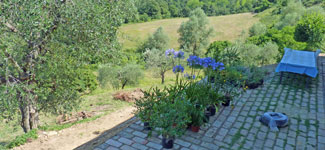 |
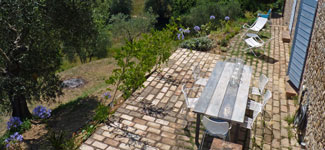 |
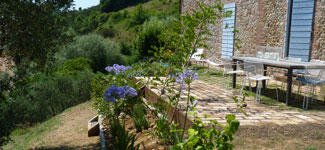 |
||||
